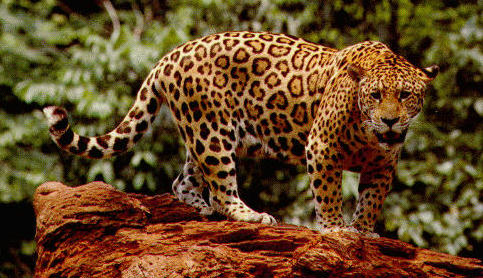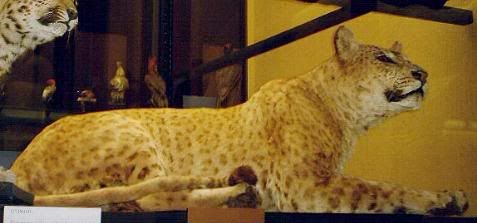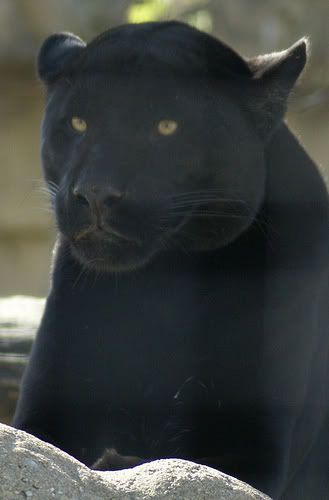

 The Accurate Reloading Forums
The Accurate Reloading Forums  THE ACCURATE RELOADING.COM FORUMS
THE ACCURATE RELOADING.COM FORUMS  Hunting
Hunting  South American Big Game Hunting
South American Big Game Hunting  anomalous felids
anomalous felidsGo  | New  | Find  | Notify  | Tools  | Reply  |  |
| One of Us |
Interesting link to some of the odd-ball, rare, and imaginary cats of the world. South America seems to have had more than their share. http://www.messybeast.com/gene...omalous-bigcats.html Jaglion  Beautifully colored jaguar with collar  SOUTH AMERICA The Cougar Noire or Jaguarete (Brazil and Guiana [Guyana]) was described as a scarce species in the 18th century and depicted in Thomas Bewick's "General History of Quadrupeds" (1790) and in Buffon's Natural histories (below). It is also called the Black Tiger ("tigre" being Spanish for jaguar) " The black tiger's hair is blackish, interspersed with spots even blacker than those of the jaguar." Note: "Jaguarete" is now used for the ocelot, but the 18th century Jaguarete was a jaguar-like big cat. Its head, back, sides, fore part of the legs, and the tail were covered with short and very glossy dusky-coloured hairs and are sometimes spotted with black, but generally lacked markings Its upper lips were white, with a black spot at the corner of the mouth. There were long hairs above each eye and long whiskers on the upper lip. The lower lip, throat, belly and the inside of the legs are whitish or very pale grey. The paws were white and the ears were pointed. The Jaguarete grew to the size of a year-old heifer. According to the naturalist Thomas Pennant, two jaguaretes were exhibited in London during the 18th century. The most likely explanation is the pseudo-melanism (abundism) mutation; this would not be unexpected in jaguars and has been recorded in African leopards. A less likely alternative is the black-and-tan mutation as seen in many dogs; surprisingly this is a mutant form of agouti (ticked tabby pattern)! The Giant Black Panther (Peru, South America) is supposedly much larger than an ordinary puma; it is most likely to be a black jaguar, a big cat whose size was further exaggerated by fearful observers. The Cunarid Din (Brazil, Guyana) recorded in Stanley E Brock's "Hunting in the Wilderness" is described: "The cunarid din is quite like the ticar din [normal jaguar] except that the ground colour is nearer white than orange or yellow. The Indians say that the white kind always attain a much larger size than the former, but this is doubtful as a fact The spots are often finer on the fore quarters and spaced further apart, and there are noticeably fewer spots within the rosettes along the sides of the body, giving the skin a rather leopard-like appearance" There are a variety of "Tigers" reported from Peru and most correspond to colour morphs of the jaguar. The Speckled Tiger (Peru, South America) of the rainforests of Peru is most likely to be an anomalous colour form of jaguar where the spots have broken up. The Speckled Tiger is described as the same size as a jaguar, but has a larger head. It is grey in colour, covered with solid black speckles. Confusing, the local name for jaguar is "tiger" since Spanish settlers named New World big cats after familiar Old World big cats. The Striped Tiger (Peru, South America) is probably due to abundism where the spots have coalesced into stripes and swirls. The Striped Tiger (Peru) inhabits hilly and lowland rainforests and is as large as a jaguar, but with tiger-like stripes. There are reports of unidentified striped cats elsewhere in South America. In "The Cloud Forest" (1966), Peter Matthiessen wrote of meeting a seaman called Picquet while travelling through Paraguay. Picquet recounted "a rare striped cat not quite so large as a jaguar and very timid, which is possessed of two very large protruding teeth" that inhabited the mountain jungles of Colombia and Ecuador. The Leopard-Spotted Jaguar (Peru, South America) is a known anomalous colour form of jaguar. The Jungle Lion (Peru, South America) is described as a large lion-like species and is likely to be an anomalous colour form of jaguar lacking clear spots. These colour morphs have been observed in other big cats and would not be unexpected in jaguars. The Red Tiger is an alternative name for the cougar. In 1994, Peter Hocking obtained skulls of a female South American Striped Tiger and though the photos only show the skulls face-on, the striped tiger’s skull is visibly narrower than a jaguar's skull though the canine teeth turn out to be no longer than those of the jaguar. The skull of the striped tiger apparently does not correspond to any known species. The skull of the speckled tiger (also female) has robust, tusk-like fangs and the whole skull is sturdier than that of either the jaguar or the striped tiger. The Jungle Wildcat, Waracabra/Warracaba Tiger or Y'agamisheri (Peru & Guyana South America) is described as differing from the jaguar in that it hunts in prides or packs, whereas the jaguar is a solitary hunter. In my opinion it is probably a mother hunting with half-grown kittens! They are also said to vary in size and have also been described as small cats - this would accord with a mother with cubs. Stories of packs of up to 100 individuals must be attributed to folklore. The fact that they are heard but not seen indicates that the real identity of the Waracabra is the nocturnal and social bush-dog. The Jungle Wildcat (Peru) is the size of a domestic cat, has a blotched pattern and noticeably long fangs. It hunts in packs of ten or more individuals.The Social Jungle Cat or Tsere-Yawa (Ecuador, South America) is described as a small, brown, semi-aquatic felid that hunts in packs of 8 to 10 individuals. The Mitla (Bolivia) is described as a black doglike cat about the size of a foxhound. Likely candidates are the bush-dog and the small-eared dog. The small-eared dog is a remarkably cat-like animal. Dark-brown to black on its back and dull reddish-brown on its underside. Siemel's Mystery Cat (Mato Grosso) was an odd-looking cat shot by Sacha Siemel. It was heavily built in appearance, with a fawn base colour, brown spots and a dark dorsal stripe. Siemel suggested it was a jaguar x puma hybrid; these have been alleged in captivity, but in the wild, the two species avoid each other. It is genetically possible as puma x leopard hybrids were bred in the 1890s in Germany and were greyish with brown rosettes. Alternatively, and more likely, it was a puma that had retained its juvenile markings into adulthood. Several photographs of patterned pumas now exist. This is analogous to the spotted lions of the Aberdares. South American Sabre-tooths (Colombia, Ecuador, Paraguay). The existence of indigenous art depicting cats with long canines has been seen as evidence that sabre-toothed big cats (Smilodon, Machairodus or the marsupial Thylacosmilus) survived until relatively recently i.e. long enough for them to have been depicted by indigenous Indians. There is an eyewitness account of a striped cat, smaller than a jaguar and having two very large protruding teeth. A "mutant jaguar" with fangs 12 inches long was shot in Paraguay in 1975, but the account cannot be authenticated. The Shiashia-Yawa (Ecuador, South America) is claimed to be a jaguar-like feline, well known to native hunters, with solid black spots on white fur. It is smaller than a jaguar. It is most likely the jaguar equivalent of a white tiger (a chinchilla mutation). Another small, spotted South American cat is the Geoffroy's Cat. The Pama-Yawa or Tapir Tiger (Ecuador, South America) is said to be a giant (7 ft long) grey felid that routinely hunts tapirs. Again, a form of jaguar is suspected. The Entzaeia-Yawa or Water Tiger (Ecuador, South America) apparently ranges from white through brown/reddish/tawny to black, with long hair and a bushy tail. It is reputed to be a man-killer so its description has undoubtedly been exaggerated by fear and folklore while the various colours may be due to wet fur or dried blood on the fur. Patagonia boasts two "water tigers". The Iemisch or Tigre de Agua (Water Tiger) (Patagonia) is described as a puma-sized amphibious carnivore, but its description is closer to that of an otter than to a cat. The Yaquaru is also called Tigre de Agua (Water Tiger) (Patagonia) and is said to be larger than any hunting-dog, having a yellow woolly hide, a long tapering tail and powerful claws. Horse and mules crossing the river may be dragged to the bottom, soon afterwards, their intestines float back to the surface. The Aypa (Guyana) has a tiger-like head, large teeth and a scaled neck (though wet fur may give the illusion of scales). It is worth remembering that "tiger" can also mean any fierce unidentified beast. The Maipolina (Guyana), responsible for aquatic maulings in the 1960s, was described as 4 ft long with formidably clawed feet, drooping ears and large, dark, round eyes. It had short fur, a whitish chest and a 6 inch wide whitish stripe running along its back. It was otherwise fawn in colour and had a short tufted ("cow-like") tail. It most prominent feature was its long fangs, comparable to those of a walrus. The Rainbow Tiger or Tshenkutshen (Ecuador, South America) has a white coat, spotted with black and striped with black, white, red and yellow across its chest. It is described as arboreal and agile in trees with front paws adapted for grasping branches. It is considered the most dangerous animal in the jungle. The pattern is reminiscent of a margay or ocelot; the margay is particularly arboreal, though a jaguar (particularly one with fresh blood on its chest) is the most likely candidate. Honduras Tigers. In 1972 there were reports that persons from neighbouring El Salvador sometimes hunted Bengal tigers in Honduras; these being the descendants of tigers that had escaped some years earlier from a circus and bred in the wild. Steve "He wins the most, who honour saves. Success is not the test." Ryan "Those who vote decide nothing. Those who count the vote decide everything." Stalin Tanzania 06 Argentina08 Argentina Australia06 Argentina 07 Namibia Arnhemland10 Belize2011 Moz04 Moz 09 | ||
|
| one of us |
Steve: formidable work. Now a question: it is not Yaguarete the Guarani for jaguar?. | |||
|
| One of Us |
nainital, I just found this info on the internet and posted it for interest sake. It was formidable work for someone, just not me. I believe you are correct on the "Yaguarete". The author is quoting an English work on South American quadripeds from 1790 on that, and he was undoubtedly confused. More links for critters: http://www.xcalak.info/visit/uk/mammels-uk.shtml http://www.nicoyapeninsula.com/wildlife/wildcats.html Steve "He wins the most, who honour saves. Success is not the test." Ryan "Those who vote decide nothing. Those who count the vote decide everything." Stalin Tanzania 06 Argentina08 Argentina Australia06 Argentina 07 Namibia Arnhemland10 Belize2011 Moz04 Moz 09 | |||
|
| one of us |
Yaguareté, jaguar, onca and tigre are different names for the same animal. You have them jet black or yellow with black spots.  L | |||
|
| one of us |
Lorenzo: yes, I thought that. Ten years ago I filmed (unfortunately with an old style camera and didn´t learn yet how to digitalize) an enormous black jag at a zoo near Cancun, Mexico. There were also two very big pumas and the jag dwarfed them. Perhaps you know the place, it´s well known but I don´t remember its name. You posted a nice picture indeed. | |||
|
| Powered by Social Strata |
| Please Wait. Your request is being processed... |
|

Visit our on-line store for AR Memorabilia

